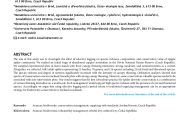Obsah
The aim of this study was to investigate the effect of selective logging on species richness, composition, and conservation value of epigeic spider community. We studied an initial stage of abandoned coppice restoration in the Děvín National Nature Reserve (Czech Republic). We sampled experimental plots in forest stands with three canopy thinning intensities: strong, moderate, and nonintervention as a control. Altogether, we collected 3,683 adult spiders representing 21 families, 70 genera, and 116 species including 23 red-listed and threatened species. The species richness and degree of rareness significantly increased with the intensity of canopy thinning. Ordination analyses showed that species of conservation concern inclined towards plots with strong canopy thinning. However, some conservation-valuable species tended to be associated with non-intervention plots. Our results suggest that the best silviculture practice for spider diversity conservation is a combination of various thinning intensities on a small scale. Such management would support high species richness with the presence of rare and threatened species. Accordingly, we argue that using selective logging and a partial return to traditional coppicing management can be an appropriate strategy for biodiversity conservation in lowland woodlands.



